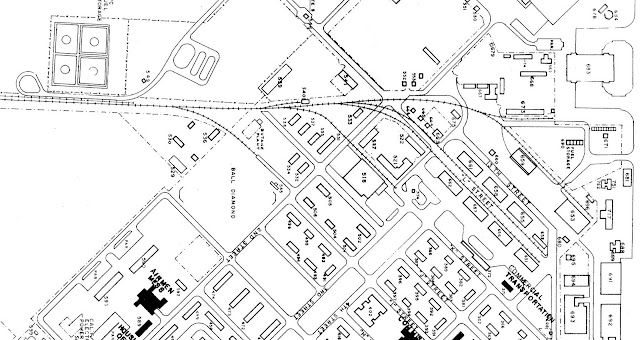Last time we completed our tour of all the scenes planned for my Victorville layout, so I've decided to start on a new tour, using some new photos. As for layout progress, I've wired and tested the three-track stub yard on Section 9, so I'll report on that too.
Earlier today I sent out a request to my friends to see whether any of them would like to help me build any of the structures I'll need for my layout. I mentioned that Bill Messecar has already built me a couple of structures. Recently he completed scratch-building the long and complex Victorville depot, compressed to fit my space but still very long. Here's the track side:
And here's the street side:
Note that both sides have an operator's bay, because they moved the depot across the tracks in the 1920s, leaving the old bay now facing the street and building a new bay facing the tracks.
Previously Bill had built for me the Campbell Sheriff's Office kit for my Barrio scene:
If you'd like to contribute to this worthy cause of filling my future layout with structures, please contact me. I will supply photos and plans, and I'll pay all costs for kits and supplies.
As we go through our 2nd tour of Victorville scenes, I will point out various structures that will need to be built.
We'll start our new tour at the Upper Narrows again, where the Santa Fe mainline tracks and the Mojave River pass between two spectacular granite cliffs. Here's a westbound Santa Fe freight after passing through the Upper Narrows:
Here's a westbound UP freight led by a gas turbine passing an eastbound Santa Fe freight that's heading through the Narrows and into Victorville:
Here's a view of the westbound Super Chief passing through the Upper Narrows on its way to Cajon Pass and Los Angeles:
On the Victorville side of the Upper Narrows we find the landmark Rainbow Bridge, as seen here behind an eastbound Santa Fe freight entering Victorville:
Here's a later postcard view showing the bridge and the cliffs of the Narrows:
Here's one final postcard view of the bridge, looking downstream, with Victorville just off the left edge of the photo:
Here's one idea for modeling the bridge, by kit-bashing a couple of Atlas Curved Chord Truss Bridge kits, as the size and shape is not too far off, although the diagonal braces would have to go. Here are some kit parts laid on top of the HO scale drawings for the bridge:
Let me know if you think this would work, or how would you build it?
Here's an old photo showing the future scene using mockups:
The cushions in back represented the cliffs of the Upper Narrows, and the blue towel represented the Mojave River. The kit in the foreground represented the Victorville Lime Rock plant, which we'll visit again next time.
As for layout progress since last time, I soldered most of the rail joiners, and I soldered 22-gauge feeder wires to the outsides of the rails near both ends of each of the three tracks in the stub yard. I connected the feeders to 14-gauge bus wires using suitcase connectors just under the front edge of the benchwork, for easy reach.
I got out an old Athearn F7 that had been in its box for over 50 years, and it started right up and was able to run back and forth on each of the three tracks, controlled by my new MRC Tech 7 power pack. Here's a photo of me in the background running the loco in the foreground (a milestone moment!):
The next step was to lay down more cork roadbed for the other five tracks on Section 9. I thought the IBL cork turnout pads I'd bought would save time in cutting all the wedge shapes needed under turnouts, but they are not nearly long enough to help, so the wedges of cork will still be needed just past the pads. Here's a recent photo of the turnout pads and the cork roadbed, but they are not yet glued down with caulk, and the wedges still need be cut, as you can see:
So, I'll keep working toward the goal of having all the cork and all the tracks laid and wired for Section 9 and then for Sections 10 and 11.


























